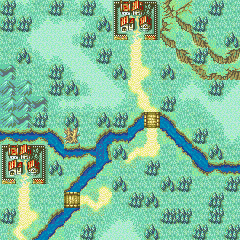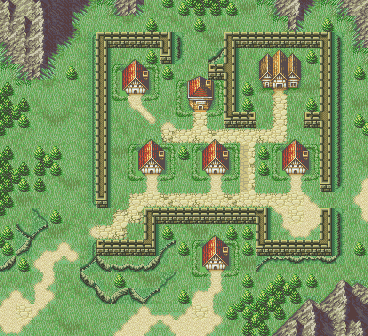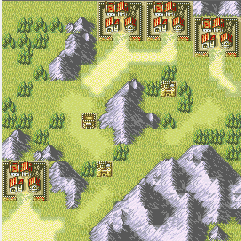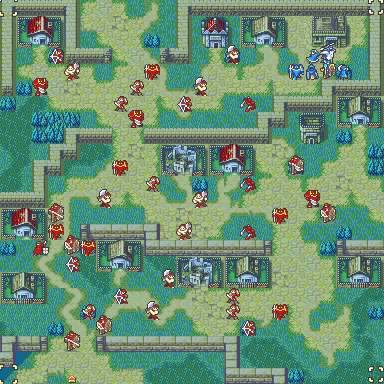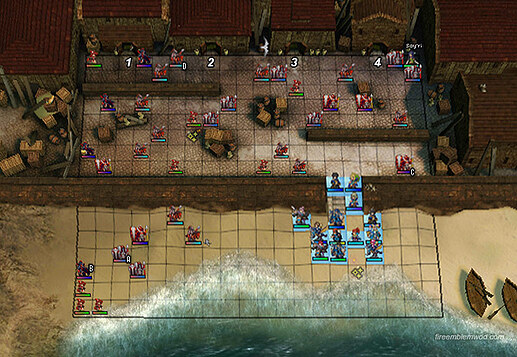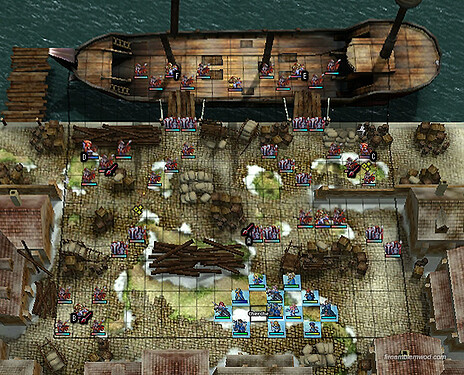(Warning: Very long post)
Part 2.
(I just got the 5 year anniversary badge, pls don’t ban me for doubleposting. Also the first post is rather long & I’d rather continue my guide/discussion/monologue in a separate post.)
Yesterday I explained what I feel makes a solid map: one that is “Simple, Clean, and not overly restrictive.”
Here are some more examples:
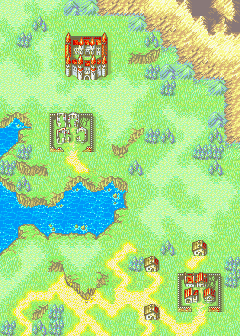

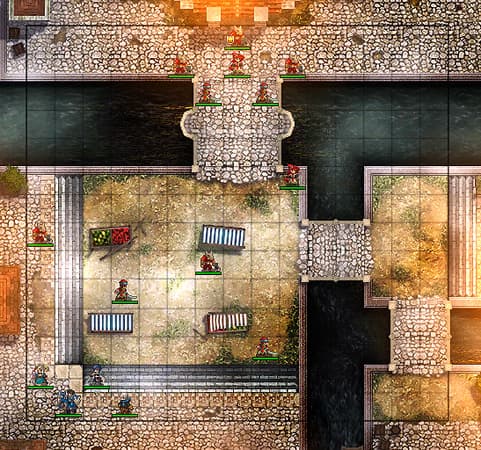
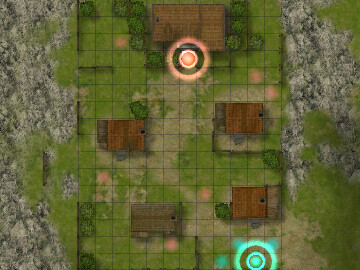

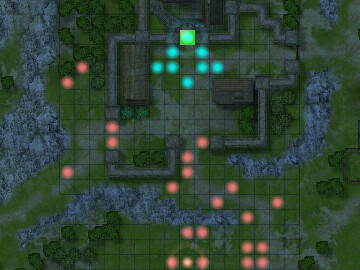

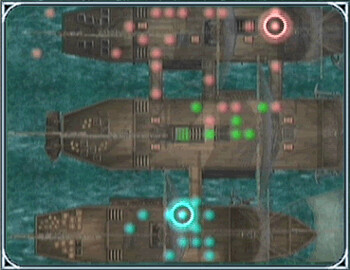

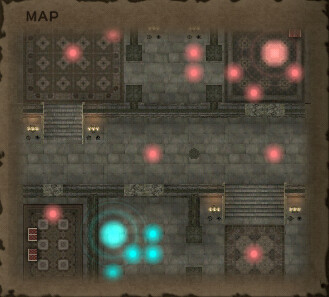
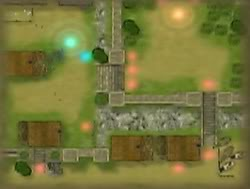
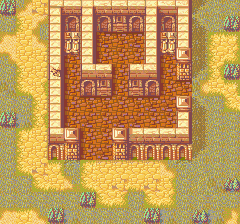
These maps usually have:
- more than one way to progress,
- open areas where player units can engage in battle (and trade with each other easily),
- pathways or allyways which the player can turn into chokepoints
- terrain features which the player can play around and use, but that don’t impede forward movement.
A map doesn’t need to have all 4 of these things to be good, but I feel that if you’re missing 1 or more of them then that map should be the exception to the rule, not the standard.
Here are some examples of good maps (or rather maps that I think are good) which lack one or more of these traits:



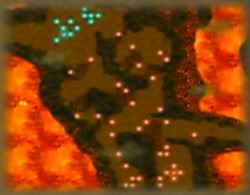

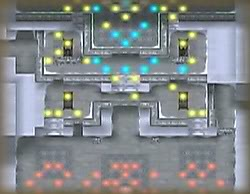
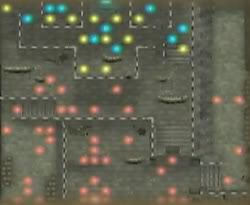
(Sorry I’m pulling so much from Tellius, those just happen to be the games I’m most familiar/spent the most time with. Also sorry the images are such poor quality, it’s surprisingly difficult to find FE maps on the internet)
These maps work because of their place in the game’s story, and because of their enemy placements.
-
The first 1 is a tutorial chapter, so appropriately it keeps fluff/decoration to a minimum and simply teaches you how to attack, use items, and sieze.
-
This chapter comes about 75% of the way into FE9 where the game has slowed down quite a bit and started to get quite boring. You have an army on the war path, and you’ve been on the war path for several months. So the game gives you a chapter called “Clash!” where they throw you into an open field, give you 19 deployment slots, and say “Have fun killing stuff!” It’s a massive battle against a bunch of beast laguz & allows you to just enjoy using all your different characters without having to worry about time constraints, or archers, or item effectiveness or really much of anything aside from “how do I kill those guys without my guys dying?” which for me is really what’s at the heart of FE’s gameplay.
-
This is the second chapter of fe 10. This chapter says to the player “Our people are poor, hungry, and oppressed, and there are 4/5 heroes who have risen up to oppose the tyrannical rule of the empire.” It does this by giving you 1 unit which can battle normally, 1 unit which can survive 1 round of combat, and two units which deal damage but die instantly. The solution is to put the 4 units into a chain and have them run down the center of the level. It also communicates that sometimes the goal isn’t to kill every enemy, but rather to trigger the chapter end as soon as you can.
-
This is another “Kill stuff” chapter, but for some reason I’ve always had a fond experience when I’ve played through it. Maybe it’s because it comes just as your main cast are hitting their second promotions and are able to begin showing off their endgame builds & abilities.
-
This chapter only has 1 path forward, and has a lot of mountainside. Usually those two things are a recipe for disaster, but again I’ve always enjoyed this chapter. I think it’s because the open space in the center allows you to play around with different units killing wyverns without having to deal with pressure to kill a thief or save a house or the threat of overleveled units spawning behind you.
-
& 7. These chapters are glorified cutscenes, they are tools for the game’s storytelling which give you a hands on depiction of key worldbuilding events. In both chapters you defend against an “overwhelming” offensive force & either watch the yellow units carry you to victory or place a couple player units on some chokepoints and then sit and watch. Either way, they are significant for their worldbuilding, not their gameplay.
–
Finally, the reason I wanted to come a make a second post: What makes the difference between a “good” or “solid” map, and a “great” or “excellent” map?
And the answer is: Map design is only half the battle.
“What?”
The difference between a “good” map and a “phenomenal” map isn’t in the map, it’s in the level design. It’s the chapter design, the enemy placements, the reinforcement spawns, the story beats, and the player’s team.
Example: (which I know I’ve used somewhere else sometime in the last 5 years cause it’s my go-to example for this topic)
–
FE9 Chapter 11: Blood Runs Red
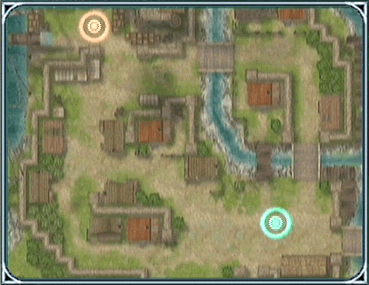
Take a good long look at this map. No really, I’ll wait.
…
…
…
Got it? Good. You start in the bottom right, and there’s 3 paths (4 technically but no one wants to shove their units through a 1 tile) and you make your way to the top left. It’s simple, it’s clean, and aside from the “Forbidden bridge” there’s no 1 tile-ing.
Let’s take another look at my 4 criteria from earlier real quick:
“1. more than one way to progress” Check.
“2. open areas where player units can engage in battle” There’re only 2, but it’s good enough. Check.
“3. pathways or allyways which the player can turn into chokepoints” Triple Check.
“4. terrain features which the player can play around and use, but that don’t impede forward movement.” Check. (You can’t see them well here, but there are bushes along the side the player can use while healing their units.)
Yay, it’s a solid map. But what makes this map any different from the maps I shared at the beginning of the post?
Gameplay.
You start in the bottom right, and kill a couple red units in the open area. There are then 3-4 village houses to go get items from,(there’s also an enemy myrmidon recruit on the right if you’d like to get him). Obviously you can split your team 2-4 ways to grab the different items, or can try to funnel them all down a single path. Both work fine.
After maybe 5-7 turns some wyverns spawn in the lower right corner, two of them are a sleepy old guy and a young hothead girl, they have some amusing dialogue. The wyverns then agrro you, but the old guy (the only one which really seems threatening) takes a nap and doesn’t bother you.
These wyverns are significant because they ensure that however you split up your team, each of your squads have a caboose (Someone who secures the backline) This is important, because often times in FE the strong units end up in the front along with whoever is being trained, and the mages and healers end up slightly behind, having enemy units spawn behind the team encourages the player to reserve a fighter or 2 to protect the weaker units.
So then things progress as normal. There’s sword fighters on the right, axe fighters on the left, some calvary units in the upper left, and well, normal fire emblem gameplay.
Near the end of the chapter, there’s either a turn event or an area event (don’t remember which, I want to say it’s once ike passes into the final 3rd of the map, which was usually around turn 12 for me) where the game’s main antagonist steps out from one of the village houses (I think it’s one that you visit too) and slowly walks toward the player. It’s terrifying, completely unexpected, and his 20/20 + divine weapon bonus stats are awe inspiring to look at. I remember trying to calculate which of my party members would even be able to get damage on him.
Now there’s a timer on the player. The chapter boss (a respectable level 12 calvary if I recall correctly) doesn’t even seem threatening anymore, the archers and units around the boss? Don’t care. Everything turns into a blind rush to get your units out of town and onto the boat (it’s an escape chapter).
Story-wise this is brilliant. This chapter is the last time the main cast will be in their homeland until the very end of the game. You don’t realize it whilst playing, but this chapter is the climax to the game’s first major story arc. The evil empire has invaded, the greil mercenaries have had to flee their base, and now hiding away in a little port town on the edge of the kingdom, even there it is no longer safe for them. This chapter is the final stage of them fleeing for there lives and truly taking up the status of vagabonds. Additionally, this is I believe the first chapter where they must take up sword against their own countrymen. They are no longer just fighting daein troops, but their own kith and kin. Hence the chapter’s remarkably intense name: Blood Runs Red
(Moreso in a casual playthrough where it is not uncommon for several of the player’s units to fall here.)
Should every single chapter be like this? No. This is just an example of how combining solid (even if not top tier) map design with compelling storybeats and substantive gameplay can create for an unforgettable experience.
–
If I’m quite honest, I don’t think every chapter in an FE game needs to knock it out of the park. It is perfectly fine for several chapters to just be “ok” or “decent” or “good enough” but every now and then, it is really refreshing to play a level which feels truly inspired, heavily thought out, and well tested.
This is likely the longest post I’ve ever made on a website, hopefully it was constructive for those who are interested in this topic.
And finally! Some food for thought:
Here are two maps from our beloved FE7 which showcase almost everything you shouldn’t do when designing a map:
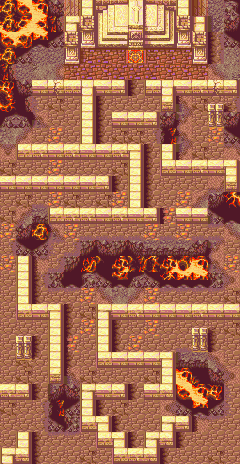
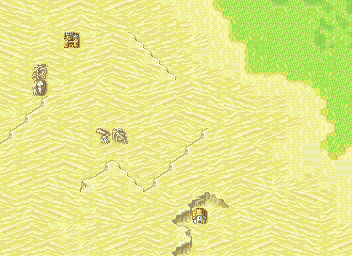
(PS: Damnit, I forgot to talk about genning.
Okay, short version: If you’re brand new, or stuck, or just want to get practice with tilesets and blending then generate to your heart’s content. If you’re somewhat experienced with Fire Emblem design, and have a somewhat hefty level of experience with the mainline games then you should almost never gen. The quality difference in a genned, or partially genned map, and a fully handcrafted map is palpable. Again, if you’re pretty familiar with mainline FE I recommend learning how to handcraft maps. Even if your first few maps are simple or small, I promise the quality difference makes up for it in the long run.)
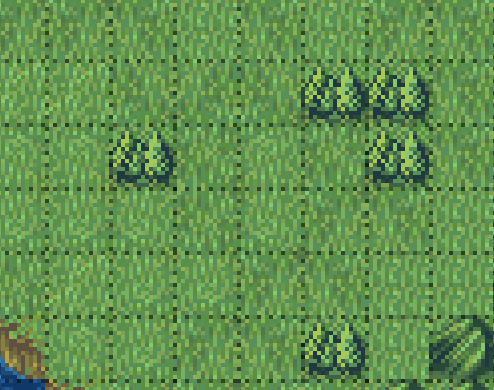
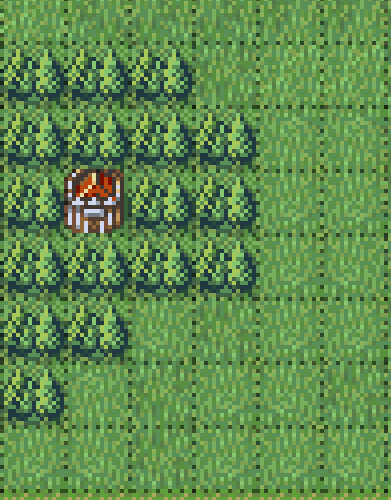 )
)
